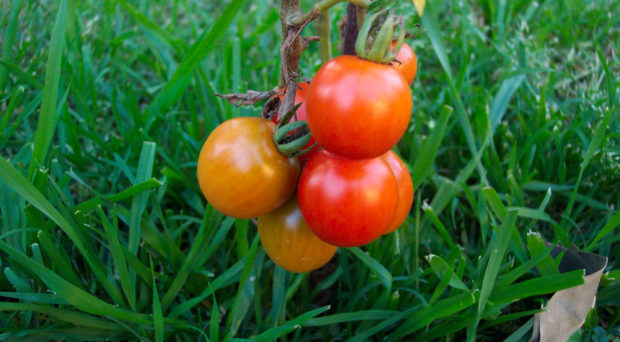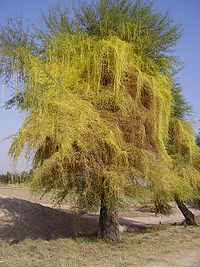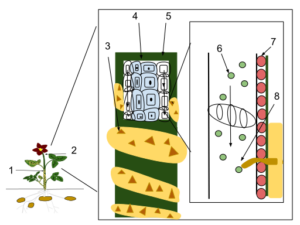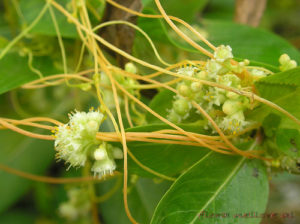
Plants are susceptible to a large range of microbial pathogens such as bacteria and fungi and have a well-developed innate immune system to counter these attacks. This includes a surveillance system that detects structures that are conserved amongst a variety of pathogens and are known as microbe-associated molecular patterns (MAMPS). These MAMPS are detected by plant pattern recognition receptors localised on the surface of plant cells and their recognition induces defence reactions such as the production of reactive oxygen species.
In addition to attack by microbes, parasitic plants can invade other plants. Despite the threat to crops that these parasitic plants pose, little is known about the immune responses, if any, that are directed against parasitic plants.

Dodders
Dodders belong to the genus Cuscuta which includes well over 100 parasitic plants. They produce hair like stems or vines with leaves reduced to small scales that can smother the host plant, hence their numerous folk names including devil’s hair, witches’ hair and strangle weed. Their flowers produce large quantities of tiny seeds that persist in the soil for up to 10 years. When the seeds germinate the seedlings can sense chemical cues given off by their preferred hosts and grow towards them.
Dodders have no chlorophyll and cannot photosynthesise, instead they wind round the host plant’s stems and send out appendages called haustoria that penetrate the host and absorb nutrients from its vascular system. In addition to absorbing nutrients there is an exchange of macromolecules and viruses between host and parasite. Thus, in addition to weakening and even strangling the host plant, dodders can transmit viruses from host to host as they wind round adjacent plants.
Dodders can parasitise a wide range of hosts including many agricultural and horticultural crops, causing severe economic loss.

However, the cultivated tomato plant is able to resist attack by exhibiting a hypersensitive response. If the mechanisms behind this resistance were understood it might be possible to use this knowledge to protect susceptible crops. Members of the Centre for Plant Molecular Biology, University of Tubingen and the Sainsbury Laboratory, Norwich set out to do just that.
In their paper, recently published in Science, Markus Albert, Volker Hegenauer and colleagues asked whether tomato plants were responding to molecules on the surface of dodder cells in a similar manner to their response to the microbe-associated molecular patterns found on plant pathogens.
A plant-parasite-associated molecular pattern
Using Greater Dodder, Cuscuta reflexa, they first demonstrated that extracts from this dodder did indeed induce a response in the leaves of cultivated tomatoes similar to that engendered by the presence of microbes; namely, the release of reactive oxygen species and the synthesis of the stress-related phytohormone, ethylene. This response was not induced in related plants that are susceptible to attack by dodder, including wild tomatoes. The active factor inducing this response was associated with the cell walls of all parts of the dodder plant.
Attempts to purify the dodder molecules involved were not entirely successful, but the activity was associated with a small peptide.
Identifying the receptor
The group then sought the tomato receptor molecule that recognised this parasite-associated molecular pattern. To do this they compared genomic regions of the resistant, cultivated tomato with the susceptible, wild tomato, looking for differences that might account code for a receptor.

Five candidate genes from the cultivated tomato that were not present in the wild tomato and were predicted to encode cell surface receptor-like proteins were expressed in a plant susceptible to giant dodder, Nicotiana benthamiana (a relative of the tobacco plant that is widely used as a host in plant virology). Expression of one of these candidate genes resulted in an oxidative burst and production of ethylene typical of a response to microbes when these leaves were exposed to the dodder factor. The researchers named the protein that this gene expressed Cuscuta receptor 1 (CuR1). CuR1 was a leucine-like repeat receptor-like protein.
All the bioactive subfractions of dodder extract induced production of ethylene in the leaves of the N. benthamiana expressing CuR1, as did extracts from other dodder species.
CuR1 was then stably expressed in the wild tomato and in N. benthamiana and both plants gained resistance to attack by dodder. A hypersensitive response was visible at the site where the haustoria penetrated the host plant, disturbing the ingrowth of the dodder.
Although these findings implicate the dodder factor and CuR1 in the recognition of and defence against this parasite, the authors suggest that other factors may also be involved in what is likely to be a multi-layered defence system. Despite this, their detailed dissection of one layer of defence against a plant parasite is an admirable start.

Comments